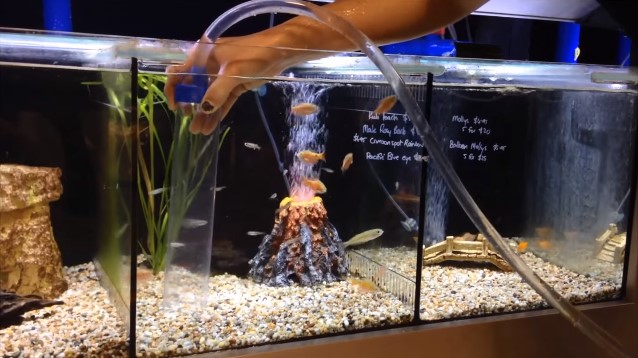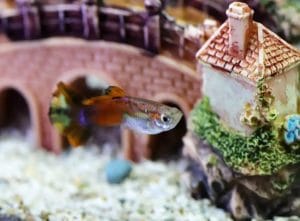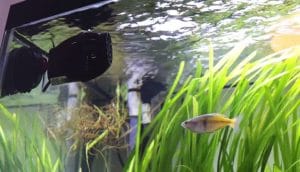Keeping your aquarium clean is the most important thing to do to keep your fish healthy. Uneaten food and waste can throw off the water chemistry and lead a lot of problems.
That said, it’s not always easy to keep your tank as clean as it needs to be. That’s where an aquarium vacuum cleaner comes in.
If you want to make the most out of your aquarium maintenance, using an aquarium vacuum cleaner can help.

The best time to use an aquarium vacuum is when you’re ready to change out a portion of the water in your tank.
Rather than taking out the relatively clean water from the top, you remove the dirtier water from the bottom which makes the whole process more effective.
Table of Contents
What Is an Aquarium Vacuum?
You might be wondering what an aquarium vacuum is. Basically, it’s a tool used to clean waste and debris from the substrate and to remove dirty water when it’s time for water changes. They’re usually made of a plastic syphon attached to a long line of tubing.
How Do You Use an Aquarium Vacuum?
First, make sure that the length of the hose and the syphon head are securely connected. This will help avoid any large spills or messes later.
Next, you need something to collect the water. The most common practice is to use a plastic bucket on the floor next to the aquarium, but you can also get setups that connect the hose to your sink for really easy drainage.
Once you have this setup, you’re ready to start. Place the head of the vacuum into the tank and allow it to fill with water. Once it’s full, lift it out of the water and allow it to drain into the bucket through the tubing. Place the head back under the water before it’s completely empty. This is the step that causes the “vacuum” effect. An air pocket forms which keeps the water coming down the hose and into the bucket. The water is pulled through the head so, by moving the head around, you can use the suction end of the tube just as you would a vacuum cleaner.
Move the head of the vacuum through the gravel on the bottom of your tank to collect any uneaten fish food, waste, and other debris. Also, if you have any decorations or faux plants in your aquarium, clean them as well. Debris easily collects in and around these items, too. The suction pulls everything down the hose and into the bucket.
Continue this until you’ve removed about 25% of the water in the tank. If the bucket is almost full, remove the vacuum from the water and allow it to empty completely. Repeat the process if you have to in order to reach 25%.
When you’re finished, use fresh water to rinse the vacuum well, including the head end and all the way through the tube. Store it in a cool, dry spot until the next time you need to use it.
What Are the Benefits of Using an Aquarium Vacuum?
The major benefit of an aquarium vacuum is that it cleans the dirtiest part of your tank. All of the dirt, debris, waste, and left behind food particles eventually settle in the bottom of the aquarium. Using an aquarium vacuum directly cleans this area.
When it’s time to change some of the water in your tank, using an aquarium vacuum removes the dirtiest water from the bottom rather than scooping the clean, recently filtered water right off the top. It’s the best way to make sure you’re getting your tank as clean as possible.











why not use a small shop vac w/ large clear hose and a restricting valve
used vac to empty water from tanks all the time put vac out window and attach garden hose w fittings or duct tape